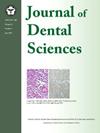金针菇多糖在糖尿病相关牙周炎中表现出有效的抗氧化和抗焦亡特性:初步的体外研究
IF 3.1
3区 医学
Q1 DENTISTRY, ORAL SURGERY & MEDICINE
引用次数: 0
摘要
背景/目的糖尿病相关性牙周炎(DAP)是一种以氧化应激升高和促炎反应为特征的复杂疾病。糖尿病与牙周炎之间存在双向关系。虽然金针菇多糖(FVP)已显示出抗炎特性,但其在DAP中的具体作用仍不确定。本研究旨在探讨FVP对晚期糖基化终产物(AGEs)和脂多糖(LPS)诱导的人牙龈成纤维细胞(HGFs)损伤的保护作用及其机制。材料和方法本研究采用AGEs和LPS处理的HGFs模拟DAP的体外环境。利用MTT法寻找不同浓度的FVP(金针菇成分之一)对细胞存活、迁移、活性氧(ROS)产生和细胞衰老的影响。Western blotting检测焦亡通路相关蛋白表达,ELISA检测促炎细胞因子IL -6、IL-8水平。结果我们的研究发现,在检测剂量下,FVP对hgf表现出最小的细胞毒性。AGEs和LPS共同处理可显著降低HGFs细胞存活和迁移能力,同时显著增加细胞内ROS水平和细胞衰老标志物p16的表达。然而,FVP治疗恢复了这些AGE和lps诱导的不良反应,证明了细胞存活和伤口愈合能力的恢复,ROS的产生,以及p16蛋白表达的降低。FVP通过降低焦亡标志物(凋亡相关斑点样蛋白含caspase募集域(ASC)、NLR家族pyrin结构域3 (NLRP3)、caspase-1、gasdermin D (GSDMD)和IL-1β)抑制AGEs和lps诱导的细胞焦亡。此外,FVP显著降低促炎细胞因子的产生水平,包括IL-6和IL-8。结论FVP对AGEs和LPS所致的牙龈成纤维细胞损伤具有明显的保护作用。添加FVP可以逆转由AGEs和LPS引起的细胞氧化应激、伤口愈合不良、炎症和焦亡等病理过程。这些发现表明,FVP可以有效地作为治疗或辅助治疗DAP。本文章由计算机程序翻译,如有差异,请以英文原文为准。
Flammulina velutipes polysaccharides exhibit potent antioxidant and anti-pyroptotic properties in diabetes-associated periodontitis: A preliminary in vitro study
Background/purpose
Diabetes-associated periodontitis (DAP) is a complicated illness characterized by elevated oxidative stress and a pro-inflammatory response. There is a bidirectional relationship between diabetes and periodontitis. Although Flammulina velutipes polysaccharides (FVP) has demonstrated anti-inflammatory properties, its specific role in DAP remains uncertain. The purpose of our study was to seek the protective effects and the underlying mechanism of FVP against advanced glycation end products (AGEs) and lipopolysaccharide (LPS)-induced damage in human gingival fibroblasts (HGFs).
Materials and methods
Our study used HGFs treated with AGEs and LPS to mimic the in vitro environment of DAP. MTT assay was utilized to seek the various concentrations of FVP (a component of Flammulina velutipes) affected cell survival, migration, reactive oxygen species (ROS) generation, and cell senescence. Western blotting was used to evaluate the expression of pyroptosis pathway-related proteins, while ELISA was used to detect proinflammatory cytokines interleukin (IL)-6 and IL-8 levels.
Results
Our study discovered that FVP exhibited minimal cytotoxicity to HGFs at the dosages examined. Co-treatment with AGEs and LPS dramatically reduced HGFs cell survival and migratory capacity, while considerably increasing intracellular ROS levels and expression of the cell senescence marker p16. However, the treatment of FVP restore these AGE and LPS-induced adverse effects, as evidenced by the restoration of cell survival and wound healing capacity, ROS production, and decrease the protein expression of p16. FVP inhibits AGEs and LPS-induced cell pyroptosis by lowering pyroptosis markers (apoptosis-associated speck-like protein containing a caspase recruitment domain (ASC), NLR family pyrin domain containing 3 (NLRP3), caspase-1, gasdermin D (GSDMD), and IL-1β. Furthermore, FVP dramatically decreased proinflammatory cytokine production levels, including IL-6 and IL-8.
Conclusion
The results of our study demonstrated that FVP had a significant protective effect on human gingival fibroblast damage caused by AGEs and LPS. The addition of FVP can reverse pathological processes such as cellular oxidative stress, poor wound healing, inflammaging, and pyroptosis caused by AGEs and LPS. These findings suggest that FVP could be effective as a therapeutic or adjuvant treatment for DAP.
求助全文
通过发布文献求助,成功后即可免费获取论文全文。
去求助
来源期刊

Journal of Dental Sciences
医学-牙科与口腔外科
CiteScore
5.10
自引率
14.30%
发文量
348
审稿时长
6 days
期刊介绍:
he Journal of Dental Sciences (JDS), published quarterly, is the official and open access publication of the Association for Dental Sciences of the Republic of China (ADS-ROC). The precedent journal of the JDS is the Chinese Dental Journal (CDJ) which had already been covered by MEDLINE in 1988. As the CDJ continued to prove its importance in the region, the ADS-ROC decided to move to the international community by publishing an English journal. Hence, the birth of the JDS in 2006. The JDS is indexed in the SCI Expanded since 2008. It is also indexed in Scopus, and EMCare, ScienceDirect, SIIC Data Bases.
The topics covered by the JDS include all fields of basic and clinical dentistry. Some manuscripts focusing on the study of certain endemic diseases such as dental caries and periodontal diseases in particular regions of any country as well as oral pre-cancers, oral cancers, and oral submucous fibrosis related to betel nut chewing habit are also considered for publication. Besides, the JDS also publishes articles about the efficacy of a new treatment modality on oral verrucous hyperplasia or early oral squamous cell carcinoma.
 求助内容:
求助内容: 应助结果提醒方式:
应助结果提醒方式:


